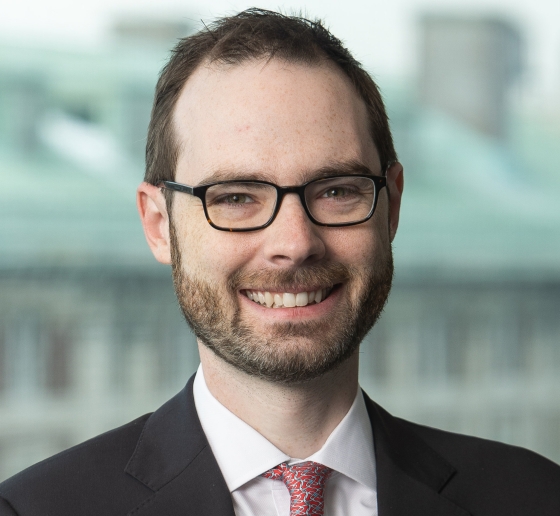Five Questions on the Fed’s Powers With Central Banking Scholar Lev Menand
Increasing reliance on the Federal Reserve to prevent financial panics and manage economic cycles shows the need to lighten the load on the central bank by strengthening banking regulation and developing new fiscal policy tools, the former U.S. Treasury official says.

From pandemic emergency-lending programs to recent interest rate hikes aimed at taming inflation, the Federal Reserve’s role in the U.S. economy has seldom been more evident. In his new book, The Fed Unbound: Central Banking in a Time of Crisis, Columbia Law School Associate Professor Lev Menand argues that we are relying too heavily on the U.S. central bank. Change is needed, he says, before another meltdown risks a repeat of the Great Recession or worse.
What is the Fed’s proper role?
The Fed’s job is to maintain continuity of service in money and payments and manage the overall supply of money available to households and businesses. In a commercial economy like ours, the money supply is a piece of critical infrastructure. It’s like the electricity grid. If you turn it off for even a couple of days, you undercut the ability of businesses to operate. In September of 2008, the grid was severely compromised for less than a month, and millions of people ultimately lost their jobs. The Fed worked hard in 2020—expanding its balance sheet by trillions of dollars in a short period of time—to prevent that from happening again. But it’s not supposed to take so much work to keep the lights on.
Right now the Fed is raising interest rates to try to curtail inflation, which is currently close to a 40-year-high at over 7%. The stock and housing markets don’t like it—but isn’t controlling inflation the job of the central bank?
Yes—to a point. The Fed’s job is to stimulate the expansion of the money supply so that its growth is consistent with the economy achieving full capacity utilization—maximum employment, price stability, and moderate long term interest rates—over the long run. Excessive monetary expansion is destabilizing and will undermine this goal. But not all inflationary episodes are a product of excessive monetary expansion; nor is an acute monetary contraction a good way to achieve full capacity utilization in the long run. Nonetheless, following the oil price shock of the late 1970s, it was the Fed that ended a decade of price instability by raising the federal funds rate to a high of 20% in 1981.
In the wake of that episode, policymakers abandoned fiscal policy tools like credit controls or wage controls and shifted the focus to the Fed to achieve a 2% annual inflation rate even when problems in the economy have nothing to do with money supply and credit expansion.
This is a suboptimal approach to macroeconomic management. You can think of it this way: The Fed only has a hammer while generally only part of the problem of booms and busts are nails. We should develop fiscal policy tools—ways to adjust taxes and spending—as well as credit policy tools—ways to adjust borrowing—in addition to relying on monetary policy.
How did the pandemic-induced economic shutdown affect the role of the Federal Reserve? Did the Fed do the wrong thing?
The Fed has been engaged in near-constant crisis management since the 2008 financial crisis, when Fed officials lent $30 billion to stave off the bankruptcy of the broker-dealer Bear Stearns and over $100 billion to rescue the insurance conglomerate AIG.
When the pandemic occurred in 2020, the Fed acted again as a backstop when it intervened with $3 trillion of support for financial firms. The Fed then went further by putting a floor under asset prices, buying financial assets—including corporate bonds for the first time—and opening lending programs for ordinary businesses and municipalities. It even lent to the Metropolitan Transit Authority, which runs the New York subways.
Combined with its quantitative easing program, which increased the money supply, the Fed’s response during the pandemic drove stocks, bonds, and real estate prices to all-time highs, even though economic activity was well below pre-pandemic trends.
My concern with the Fed’s response is two-fold. First, financial firms shouldn’t require such an open-ended government backstop: We need to strengthen the system so that it is more stable. Second, the Fed is doing the job of multiple institutions at once. It runs the risk of overload trying to compensate for major deficiencies in the rest of our legal and policy-making framework. In both conventional monetary policy and unconventional lending, we’re now relying on the Fed to do way too much.
How did the Fed end up bailing out the entire financial system instead of just banks?
Unfortunately, in today’s system, “shadow banks” are critical players in our monetary system that the Fed has to step in to save if it wants to ensure continuity of service in money and payments.
Shadow banking—the creation of money instruments outside of the Fed-supervised chartered banking system—was the result of a multi-decade effort to liberalize the financial system. It began with the Fed’s own decision to allow non-bank broker-dealer firms such as Bear Stearns and Lehman Brothers to operate like banks and create a deposit alternative known as a repurchase agreement or “repo.” The Fed also facilitated the expansion of another deposit alternative called Eurodollars, which circulate overseas.
One consequence of these new “non-deposit deposits” is pressure on chartered banks’ deposit bases. Bank regulators responded by easing the restrictions on bank activities, allowing banks to do things they were previously prohibited from doing. As the shadow banks got bigger and bigger, banks got bigger and bigger and more complex.
Fast forward, and by 2008, we have a system in which most of the money supply is in shadow banks. The Fed doesn’t have supervisory authority over these shadow banks. These firms aren’t subject to banking law. There’s no deposit insurance. So there’s no explicit government backstop for repos and other money instruments that these firms are issuing. The Fed doesn’t have the tools to control the size and composition of shadow bank balance sheets. And so it lost control, and we ended up with the Great Recession. All the Fed could manage was to step in after things went wrong and try to prevent these firms from complete collapse.
Should the government bail out failed investment banks in financial crises?
It’s in the public interest to stop a monetary panic. However, I’m deeply troubled by the government being in a position of having to bail out shadow banks in order to prevent economic implosion. I’m very troubled by the commitment of public funds to support the system in 2008 and 2020. The current arrangement, which some people are comfortable with because they think, well, things will go wrong again and the Fed can just write a big check, is really problematic. That’s why we need to build a better mousetrap.
What regulatory changes are needed?
One is monetary system reform. The foundation of securities law is the definition of a security. If you are issuing securities and they are functionally equivalent to this definition, no matter how you dress them up, securities laws apply. The same thing is true in insurance. We have a functional definition of what an insurance arrangement is, and if you are engaged with a counterparty in something that functions as insurance, insurance laws apply. For the entire history of the country, we’ve had a relatively formalistic definition of bank money, which we haven’t applied functionally. And so our banking laws are vulnerable to arbitrage because the Fed’s tools only apply to what is formally money, instead of what is functionally money. We have to subject all of the functional money to the ambit of monetary policy.
I’d also like to see Congress develop additional tools to tackle inflation and recessions. One obvious mechanism is to add more automatic fiscal stabilizers, by which Congress itself increases government spending during recessionary periods and contracts government spending during inflationary periods. The automatic stabilizers in 2009 were a major reason why the Great Recession wasn’t a Great Depression. The government automatically dialed up its expenditures in 2009, ran a big deficit, and that stabilized the economy. If you had more of that—if the stimulus had been bigger and gone on longer—you would likely not have needed quantitative easing and a zero-interest-rate policy, and certainly not for as long as we did.
Congress might also consider developing capacity to manage credit more directly. Credit controls, which some other central banks have, can be used to slow down an overheated economy in a way that is more targeted when compared to rapid increases in the overnight federal funds rate.
This interview has been edited and condensed.
